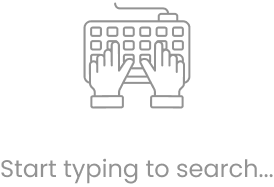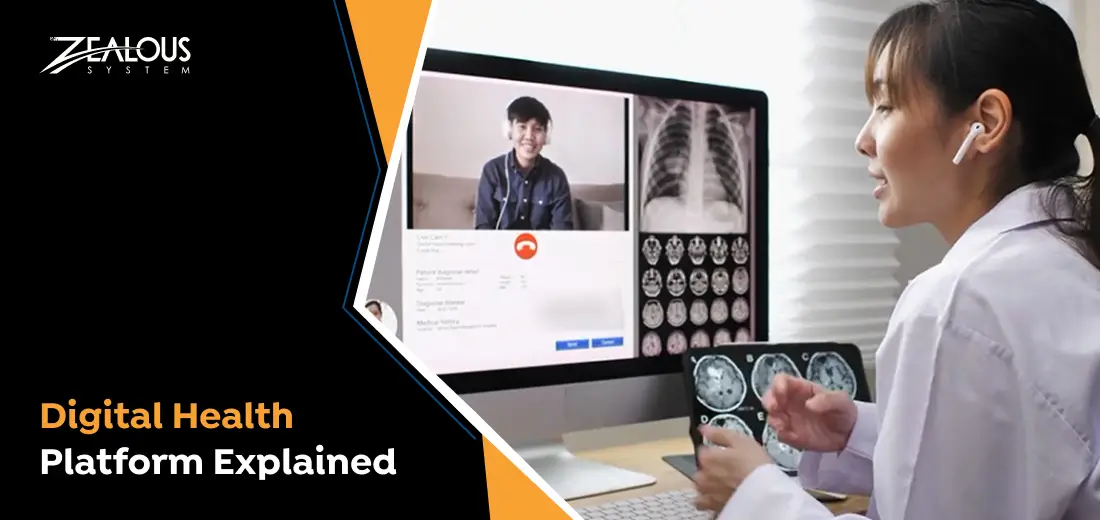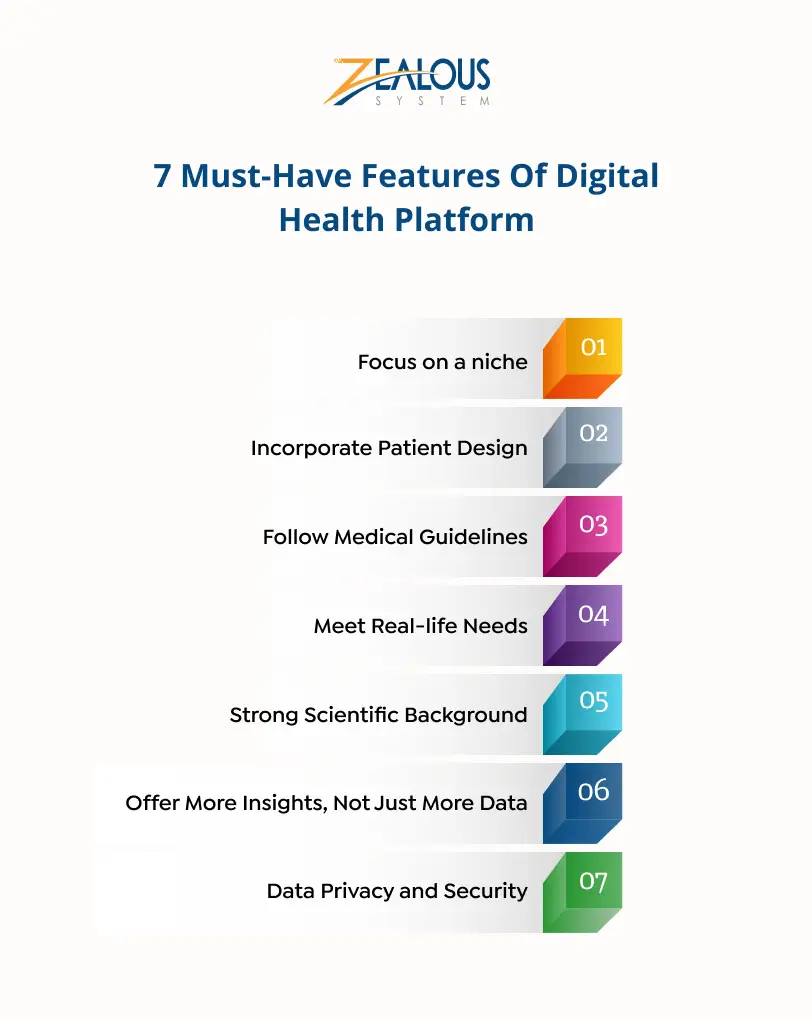


The digital revolution is transforming industries worldwide, and healthcare is no exception. Digital health platforms are leading this change by providing new ways to improve patient care, make operations more efficient, and enhance overall healthcare results.
A digital health platform is a technology solution that helps manage healthcare services and processes. It uses tools like cloud computing, big data, artificial intelligence (AI), and the Internet of Things (IoT) to create a single system for healthcare. This system allows for the collection, storage, analysis, and sharing of health information.
This blog explores what digital health platforms are, their key components, benefits, challenges, and the future they promise.
Grand View Research says that the global digital health market is expected to grow by 15.1% each year from 2021 to 2028, reaching $295.4 billion by 2028.
In 2023, the global digital health market was valued at $240.9 billion. It is expected to grow by 21.9% each year from 2024 to 2030. This growth is fueled by the high demand for telehealthcare platform developers, mHealth app providers, wearable device manufacturers, and e-prescription systems.

Digital health platforms are advanced technological solutions designed to manage and support healthcare services efficiently. These platforms integrate various digital tools like cloud computing, big data analytics, artificial intelligence (AI), and the Internet of Things (IoT). They serve as centralized systems that gather, store, analyze, and exchange health-related information among healthcare providers, patients, and other stakeholders.
Digital health platforms use modern technologies to make healthcare faster and more efficient. They help doctors and nurses make smart decisions by analyzing lots of data. These platforms also improve patient care by allowing doctors to monitor patients from afar and offer treatments that fit each person’s needs. Overall, they make hospitals and clinics work better by using technology to do things more smoothly.
In simple terms, digital health platforms use digital technologies to improve how healthcare is delivered, make patients healthier, and drive medical progress.
Digital health platforms consist of various components that work together to create a seamless healthcare ecosystem. These include:
Electronic Health Record (EHR) systems are like digital versions of a patient’s paper medical charts. They store all the important details about a patient’s health in one place. This includes things like medical history, diagnoses, medications, treatment plans, immunizations, allergies, X-rays, and lab test results. Authorized healthcare providers can access this information quickly and securely whenever they need it.
Telemedicine platforms allow patients and doctors to have appointments remotely using video calls, phone calls, or messaging. Telehealth includes not just medical appointments but also things like education, administration, and training done remotely.
HIE (Health Information Exchange) lets doctors and patients securely access and share medical info electronically. This makes patient care faster, better, safer, and less expensive.
mHealth apps enable patients to monitor their health, book appointments, receive reminders, and access medical information through their smartphones or tablets. These apps can track vital signs, manage chronic conditions, and provide educational content.
Wearable devices like fitness trackers and smartwatches gather health information such as heart rate, activity, and sleep patterns. When connected to the Internet of Things (IoT), these devices send this data in real-time to healthcare providers, who can use it to monitor health conditions and take action when needed.
AI and machine learning development use lots of health data to find patterns, predict outcomes, and suggest personalized treatments. They make diagnoses more accurate, improve treatment plans, and help patients get better results.
Cloud-based solutions provide flexible storage and computing power, making it easier to store and analyze large amounts of data. They allow healthcare providers to access health information from anywhere, which encourages teamwork among them.

Digital health platforms provide many advantages for patients, healthcare providers, and the entire healthcare system:
These platforms let patients access healthcare services and information from anywhere, making it easier to connect with healthcare providers no matter where they are.
Digital health platforms simplify tasks and organize workflows, easing the workload for healthcare providers. This means they can spend more time caring for patients instead of handling administrative tasks.
Digital health platforms come with tools that help patients communicate, learn about their health, and manage it themselves. This makes patients more involved in their own healthcare.
They help gather and analyze lots of health data. This data gives valuable insights that can improve how healthcare is provided, how well treatments work, and how to manage the health of groups of people.
They help medical research and innovation by giving access to anonymous data for studies and clinical trials, which could lead to new treatments and advancements in healthcare.
Digital health platforms save money for both healthcare providers and patients by making processes more efficient and cutting out unnecessary procedures.
They help medical research and innovation by allowing access to anonymous data for studies and clinical trials. This could lead to new treatments and healthcare improvements.

A robust digital health platform integrates several essential features that enhance healthcare delivery, patient engagement, and operational efficiency. Here are seven must-have features of a digital health platform:
Let’s tackle the big issue here: in an ideal world, we’d love to have one super health platform that covers every possible health need and tool. But that’s just not practical. It would cost a fortune to develop and maintain such a massive platform with features for every disease and condition. Plus, it would be so complicated that most people would only use a tiny fraction of what it offers—maybe just 0.2%.
A platform trying to do everything might end up doing nothing really well. It could overwhelm users with too many choices and fail to provide the specific care they really need.
Instead, focusing on a specific area allows digital health platforms to be more useful. They can concentrate on delivering better care for certain needs, which helps more people use and benefit from them. This targeted approach can lead to real improvements in how patients are treated and cared for.
Patient design is crucial for a successful digital health platform. It means involving patients as partners in creating the platform, not just building it for them. This approach ensures that developers listen to patients’ needs, preferences, and feedback from the beginning.
By doing this, developers can make platforms that are easy to use and genuinely useful. Patient design helps address real problems faced by patients, instead of just offering superficial solutions. It changes the usual relationship where patients are seen as users to one where they are seen as collaborators in their own healthcare solutions.
However, patient design isn’t simple or a one-time thing. It involves ongoing efforts like workshops, testing, and working closely with patient groups to truly understand their needs and perspectives. This approach requires dedication and openness to make sure the platform meets real-world needs effectively.
In designing digital health platforms, it’s crucial to involve both patients and medical experts from the start. This ensures the platform isn’t just a set of health-related features but a reliable tool rooted in proven medical practices. Medical professionals should be part of every stage, from designing features to staying updated on the latest research and best practices.
When platforms follow medical guidelines closely, clinicians feel more comfortable using them in their daily work. This builds trust with patients too, who see the platform as reliable because it’s based on solid research rather than passing fads.
In digital health, innovation is crucial, but it must be purposeful. Simply creating technology because we can isn’t the goal of a successful digital health platform. The first step should always be identifying a real need for patients or healthcare providers. Only after understanding this need should we think about using latest HealthTech trends to solve it.
This method ensures that the platform doesn’t just use advanced technology, but actually tackles real problems that patients and healthcare providers face. It’s about going beyond innovation for the sake of it and focusing on innovation with a clear purpose.
Be cautious about claims that aren’t backed by science. Many companies make bold promises without proper scientific studies or clinical trials to support them. It’s essential to assess the scientific basis of ideas before deciding to use them.
When any digital health platform can prove its claims through rigorous scientific research and clinical testing, it earns trust from users and the medical community. This commitment to evidence-based solutions demonstrates a focus on genuine health improvements, not just attractive features.
If you’re considering developing a digital health platform, prioritize the same safeguards you’d want as a user: look for peer-reviewed studies published in respected scientific journals, clinical trials registered in public databases, and real-world data showing benefits like improved patient health, clinical outcomes, or cost savings. These checks ensure credibility and reliability.
A digital health platform succeeds by turning user data into practical advice. While using health data for better decisions is great, the real value comes from giving users clear, understandable tips based on their data. This is crucial because, as we discussed in our earlier article on digital health anxiety, too much complex data can make users feel more anxious.
The aim should be to simplify health data, making it into useful knowledge that users can easily understand and use. This means going beyond numbers to provide explanations that help users make healthier choices, stick to medications, or know when to see a doctor. By focusing on insights that lead to positive health actions, a digital health platform can truly boost user engagement and well-being, rather than adding to their stress.
In the digital health age, keeping user data safe and private is crucial for building trust. As these platforms handle sensitive health information and use AI for personalized care, protecting this data is paramount. Users expect their personal health details to be secure from unauthorized access and breaches.
To ensure data security, it’s essential to use strong encryption, strict access controls, and continually monitor for vulnerabilities. Privacy involves respecting user consent and being transparent about how data is used, especially with AI. Users should know what data is collected, how it’s used, and how it benefits their care, without feeling exposed.
Using AI ethically in healthcare means avoiding biases in AI programming. Algorithms should improve care without unfairly discriminating or compromising user privacy or control.

Digital health platform development is a complex and dynamic process aimed at creating robust technological solutions that enhance healthcare delivery, patient outcomes, and operational efficiency. Here’s an overview of what digital health platform development entails:
The digital health platform development starts by understanding what everyone involved needs—like healthcare providers, patients, administrators, and regulators. We collect user stories, list what the system must do (like basic functions and special needs), and set clear goals and deadlines for the project.
User experience (UX) design is critical in digital health platforms to ensure intuitive and user-friendly interfaces for healthcare professionals and patients. UX designers collaborate closely with stakeholders to create wireframes, prototypes, and user journeys that prioritize usability, accessibility, and engagement.
The digital health platform includes important features like Electronic Health Records (EHR), telemedicine for remote care, mobile health apps (mHealth), and health information exchange (HIE). It uses cloud computing, APIs for connecting different systems, and secure data storage to ensure that patient information can be shared easily and accessed quickly in real-time.
Digital health platforms often implement trending technologies such as artificial intelligence (AI), machine learning (ML), Internet of Things (IoT), and blockchain. AI and ML algorithms analyze vast amounts of health data to derive actionable insights, predict patient outcomes, and personalize treatment plans. IoT devices allow remote patient monitoring and data collection, while blockchain ensures secure and tamper-proof transactions and data exchange.
Following regulations like HIPAA (Health Insurance Portability and Accountability Act) is crucial when building digital health platforms. Many developers use strong security methods such as encrypting data, controlling who can access it, keeping records of actions, and regularly checking for security issues. This protects patients’ sensitive information from being accessed without permission and from online risks.
Software testing is done at every stage of making the platform to make sure it works well, performs smoothly, and keeps information safe. The QA teams check different parts of the platform like how they work together, how easy they are to use, and how secure they are. This helps find and fix problems early on, so the platform works smoothly and reliably when it’s ready.
After finishing development and testing, the digital health platform goes live in production. It’s crucial to continuously monitor, maintain, and update it to keep it running smoothly. This ensures it performs well, can handle growth, and stays compliant with healthcare rules and tech improvements.
The tech stack for developing a digital health platform includes a combination of technologies and tools tailored to meet the specific needs of healthcare applications. Here’s a simplified overview of what it typically involves:
For the server-side logic and database management, technologies like Node.js, .NET, Python (with frameworks like Django or Flask), or Java (using Spring Boot) are commonly used. These frameworks provide robustness and scalability required for handling healthcare data securely.
SQL databases such as MySQL, PostgreSQL, or Oracle are often chosen for structured data management. NoSQL databases like MongoDB might be used for handling unstructured data and scalability.
Technologies like React.js, Angular, or Vue.js are used for building the user interface (UI). These frameworks allow for responsive and interactive user experiences, crucial for healthcare applications.
Popular platforms like Amazon Web Services (AWS), Microsoft Azure, or Google Cloud Platform (GCP) provide scalable infrastructure and services essential for hosting and managing healthcare applications securely.
You can use tools like Apache Hadoop, Apache Spark, or cloud-based services for big data processing and analytics are utilized for handling large volumes of healthcare data, enabling insights and predictive analytics.
You can use frameworks like TensorFlow, PyTorch, or Scikit-learn are employed for developing AI-driven features such as predictive diagnostics, personalized medicine, and image analysis in medical imaging.
Technologies and standards such as HIPAA (Health Insurance Portability and Accountability Act) compliance tools, SSL/TLS for secure communication, and encryption methods ensure that patient data is protected according to regulatory requirements.
If applicable, software integration with Internet of Medical Things (IoMT) devices involves protocols like HL7 (Health Level Seven International) for interoperability and secure data exchange between devices and the platform.
Tools like Jenkins, GitLab CI/CD, or CircleCI automate the build, testing, and deployment processes, ensuring rapid and reliable updates to the platform.
You can integrate telemedicine solutions and remote monitoring technologies requires WebRTC (Web Real-Time Communication), VoIP (Voice over Internet Protocol), and video conferencing tools to facilitate remote patient care.
Despite their numerous benefits, digital health platforms face several challenges:
You should keep sensitive health information secure and private is extremely important. Cyber attacks and breaches of data can make people doubt the reliability of digital health platforms.
Making different systems work together smoothly can be tricky. To achieve this, it’s important to use standard formats and rules for how data is structured and shared. This helps ensure that all systems can understand each other and exchange information correctly.
Digital health platforms need to follow specific rules and standards, like HIPAA in the US. Understanding and following these regulations can be difficult.
Not everyone can easily use digital health platforms due to things like not having internet access or not knowing how to use technology well. It’s really important to make sure that everyone has a fair chance to use them.
Doctors and patients might not want to use new technologies at first. Teaching and training are important to help them accept and use these new tools.
The future of digital health platforms is promising, with continuous advancements in technology driving innovation. Key trends to watch include:
AI will become more important in diagnosing illnesses, planning treatments, and keeping track of patients. Virtual assistants and chatbots using AI will help patients stay involved and assist healthcare providers better.
Telehealth services are expanding to offer healthcare to people in remote or underserved areas. They’ll also work with wearable devices for better remote monitoring.
Digital health platforms will support personalized medicine by using genetic and molecular data to tailor treatments to individual patients.
Blockchain technology improves the security of health data by making records tamper-proof and ensuring safe sharing of information.
It is important to make user interfaces easier to use, creating intuitive apps, and smoothly connecting different digital tools will make the patient’s overall experience better.
Digital health platforms are revolutionizing healthcare, offering innovative solutions that improve patient care, increase efficiency, and promote data-driven decision-making. While challenges exist, the benefits far outweigh them, and the future of digital health platforms looks bright.
As technology continues to evolve, these platforms will play an increasingly vital role in shaping the future of healthcare, making it more accessible, efficient, and personalized. For healthcare software development companies, staying at the forefront of these HealthTech trends is crucial to delivering cutting-edge solutions that meet the evolving needs of healthcare providers and patients alike.
Our team is always eager to know what you are looking for. Drop them a Hi!
Comments